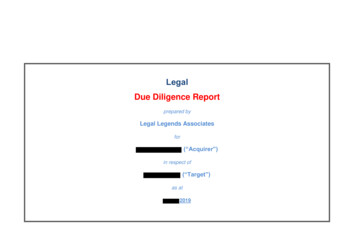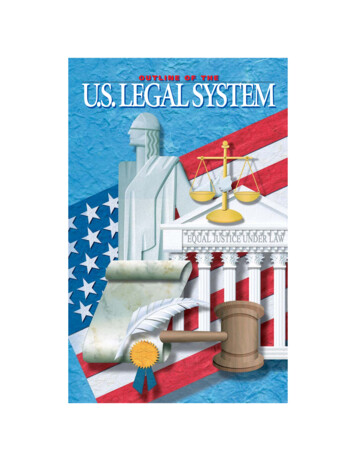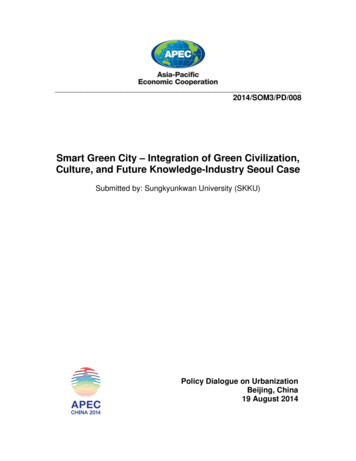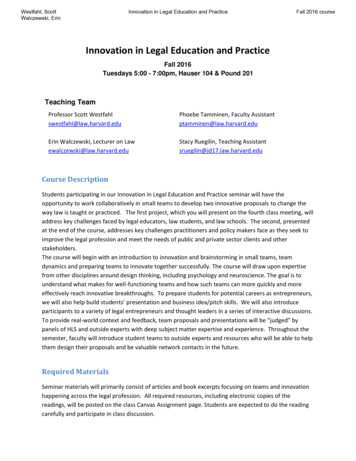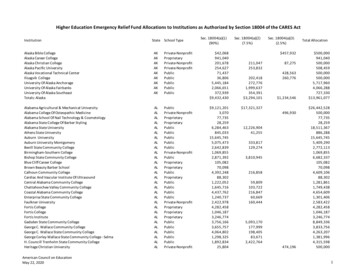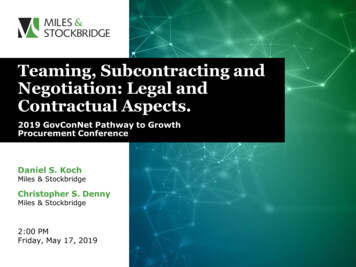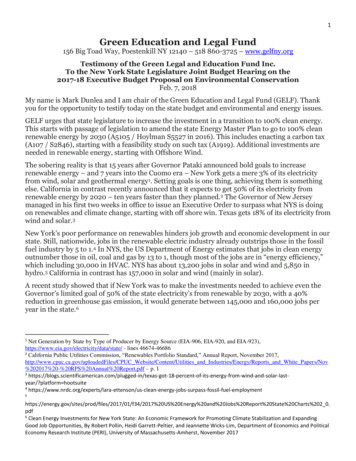
Transcription
1Green Education and Legal Fund156 Big Toad Way, Poestenkill NY 12140 – 518 860-3725 – www.gelfny.orgTestimony of the Green Legal and Education Fund Inc.To the New York State Legislature Joint Budget Hearing on the2017-18 Executive Budget Proposal on Environmental ConservationFeb. 7, 2018My name is Mark Dunlea and I am chair of the Green Education and Legal Fund (GELF). Thankyou for the opportunity to testify today on the state budget and environmental and energy issues.GELF urges that state legislature to increase the investment in a transition to 100% clean energy.This starts with passage of legislation to amend the state Energy Master Plan to go to 100% cleanrenewable energy by 2030 (A5105 / Hoylman S5527 in 2016). This includes enacting a carbon tax(A107 / S2846), starting with a feasibility study on such tax (A1919). Additional investments areneeded in renewable energy, starting with Offshore Wind.The sobering reality is that 15 years after Governor Pataki announced bold goals to increaserenewable energy – and 7 years into the Cuomo era – New York gets a mere 3% of its electricityfrom wind, solar and geothermal energy1. Setting goals is one thing, achieving them is somethingelse. California in contrast recently announced that it expects to get 50% of its electricity fromrenewable energy by 2020 – ten years faster than they planned.2 The Governor of New Jerseymanaged in his first two weeks in office to issue an Executive Order to surpass what NYS is doingon renewables and climate change, starting with off shore win. Texas gets 18% of its electricity fromwind and solar.3New York’s poor performance on renewables hinders job growth and economic development in ourstate. Still, nationwide, jobs in the renewable electric industry already outstrips those in the fossilfuel industry by 5 to 1.4 In NYS, the US Department of Energy estimates that jobs in clean energyoutnumber those in oil, coal and gas by 13 to 1, though most of the jobs are in “energy efficiency,”which including 30,000 in HVAC. NYS has about 13,200 jobs in solar and wind and 5,850 inhydro.5 California in contrast has 157,000 in solar and wind (mainly in solar).A recent study showed that if New York was to make the investments needed to achieve even theGovernor’s limited goal of 50% of the state electricity’s from renewable by 2030, with a 40%reduction in greenhouse gas emission, it would generate between 145,000 and 160,000 jobs peryear in the state.61Net Generation by State by Type of Producer by Energy Source (EIA-906, EIA-920, and e/ - lines 46674-466862California Public Utilities Commission, “Renewables Portfolio Standard,” Annual Report, November 2017,http://www.cpuc.ca.gov/uploadedFiles/CPUC Website/Content/Utilities and Industries/Energy/Reports and White Papers/Nov%202017%20-%20RPS%20Annual%20Report.pdf – p. olar-lastyear/?platform e%20Charts%202 0.pdf6Clean Energy Investments for New York State: An Economic Framework for Promoting Climate Stabilization and ExpandingGood Job Opportunities, By Robert Pollin, Heidi Garrett-Peltier, and Jeannette Wicks-Lim, Department of Economics and PoliticalEconomy Research Institute (PERI), University of Massachusetts-Amherst, November 2017
2Cuomo’s climate agenda has focused primarily on electricity – which accounts for less than 25% ofthe state’s carbon footprints. Progress has been even slower on transportation and the heating /cooling of buildings, with each accounting for about 1/3 of the state’s carbon footprints. Energyefficiency has been neglected.The Governor has been penny wise and pound foolish on energy and climate change issues. Thishas especially been true in offshore wind. To achieve 100% clean energy, one study estimated thatthe State would need 40% of its power from off shore wind7, with the area off of Long Island beingthe Saudi Arabia of wind. NY needs to make the investment in OSW that Europe has, where the lastproject bid in Germany came in at only 5 cents per Kwh, less than a third of the cost of the firstsmall project Cuomo approved for LIPA8. We saw a similar problem when Cuomo recently changedthe net metering rules for community solar farms, slowing down an industry that produces lessthan 1% of the state’s electricity.It is estimated that the transition to 100% clean energy for New York State will require 460 billionin investments over the next decades. While much of the funding will come from diverting existingplanned investments in fossil fuel infrastructure to renewable energy, significant additionalrevenues are needed. One step would be to make polluters pay through a state carbon tax, withpotential revenues of 7 billion a year. The burning of fossil fuels kills as 3,000 or more New Yorkresidents annually while causing an estimated 30 billion in damages.We need to halt any more fossil fuels infrastructure while investing in clean renewable energy.Instead Cuomo has embraced natural gas as a “cheap bridge fuel” despite the fact that methane is80 times more potent short term as a greenhouse gas compared to carbon. The Governor wants tospend 100 million to build two new plants to power the Empire State Plaza with fracked gas fromPennsylvania. He instead should make the Capitol a model for a clean energy future, pursuingrenewable alternatives such as geothermal as other states including Oklahoma have done. TheState Legislature should attach conditions to the 88 million reappropriation of funds to OGS toensure this happens.The state should adopt goals- including mandates - to energy retrofit every building in the statewithin the next decade; it should establish a program similar to Solar City where it upfronts thecosts of installing solar and other renewable energy systems on every building, recouping theinvestment through the savings in energy costs.We urge the State legislature to hold hearings on the Governor’s climate agenda, including thestudy on transitioning to 100% renewable energy which is expected to be completed by NSYERDAin 2018, with the first draft to be released this month.New York should adopt a climate action plan to quickly transition to 100% clean energy, with cleartimelines, activities, funding and benchmarks. A climate action plan is required under an existing2009 Executive Order.9 (A draft plan has sat on the DEC website for 7 years.10 )The US conferenceof Mayors recently endorsed 100% clean energy by 2035. newable-energy-electric-vehiclesclimate-change8
3We support the acceleration of efforts to expand mass transit and to move to 100% Zero EmissionVehicles. New York should work with California to adopt goals similar to Norway which requires100% of all new car sales to be 100% ZAV by 2025.New York State should promote energy democracy, with community control / ownership of theenergy system, ensuring that low and moderate income New Yorkers can participate in our energyfuture. We support the Governor’s Article VII proposals to allow NYPA to own renewables. Wesupport public ownership of much of the energy system at both the state and local level in order toreduce costs and to ensure that the energy systems meets public needs rather private profits. Weneed a Just Transition to ensure that workers and vulnerable communities are assisted.We support proposals to increase the investments in a Just Transition to clean energy, includingdedicating 40% of new climate funds to be targeted to disadvantaged communities feeling thebrunt of climate change. We need to avoid the gentrification of our energy system, ensuring thatlow-income individuals and communities can fully participate in our clean energy future. We needto support energy democracy, including the development of community shared renewables,Community Choice Aggregation, and public ownership / worker / community cooperatives.We support the proposal by Assemblymember Barrett to provide a tax credit to farmers whopractice regenerative agriculture to reduce their carbon footprint and return carbon to the soil.We support the proposal to divest the state pension funds from all fossil fuels (A3712 / Krueger).We are glad that Governor Cuomo in December announced his support for divestment and that inJanuary 2018 the NYC elected officials and union leaders who are voting members on NYC’svarious public pension funds announced their support for divestment. Divestment should beincluded as part of the state budget.We continue to oppose the Governor’s 7.6 billion subsidy to Exelon to keep open a handful of old,failing upstate nuclear plants. GELF is a plaintiff in the lawsuit filed by Clearwater challenging thisnuke bailout, where the State Supreme Court last motion rejected the state’s motion to dismissed.The state failed to adequately evaluate alternative approaches on how to spend 7.6 billion tocreate jobs and promote clean energy.We urge the state legislature to enact a ban on plastic bags, with a fee on other bags at retail outlets.We support the Governor’s budget proposals related to reducing food waste.We support New York allowing Community Choice Aggregation in NY to operate under rulessimilar to those in California, giving CCAs the power to negotiate directly for the purchase ofelectricity in order to support the development of local renewable energy sources.Climate Change is the Greatest Threat to HumanityThe COP21 Climate Agreement set 1.5 C as the new global warming limit, as the developingcountries were able to prevail upon the industrial carbon polluters that 2 degrees warming wouldbe too catastrophic for much of the planet. The goals that New York previously adopted underGovernor Paterson in 2009 and more recently by Governor Cuomo were based on the old 2degrees’ target. This was a radical change by international leaders but its implications have not yetbeen grasped here in the US.The 1.5 C marker pathway is defined as the most challenging mitigation pathway that can still bedefended as being techno-economically achievable. Climate researcher Glenn Peters has projectedthat meeting the 1.5 C target would require a global fossil fuel phase-out between 2025 and 2030,plus a large-scale effort to remove excess carbon dioxide from the atmosphere. Bill McKibben of
4350.org says it means: 85-90% of remaining carbon must stay in the ground. Emissions must bereduced by 9-10% per year to reach a de-carbonized world by 2030-2040; and the developed world(us) must reach net zero emissions in 5-10 years.The window to avoid catastrophic climate change in rapidly closing. A new study estimates that wehave one to four years left before we deplete our remaining carbon budget. 2017 was the secondhottest on record – the hottest if we account for El Nino effect.A recent article noted “we have already passed 1 C warming, and the Paris goal was to stop at 1.5 C,which we will now hit anytime from nine months to nine years. Estimates to then reach 2 C spanfrom 8 to 22 years.” Jim Walsh of Food and Water Watch stated: “In 2010, the International Panelon Climate Change stated that we have a 2/3 chance of avoiding a 1.5 C rise in temperature if wekeep CO2 emissions below 400 gigatons. But to put that in perspective, we have already emitted200 gigatons of CO2 since 2010. At our current rate of nearly 40 gigatons of CO2 each year, we willexceed that 400 gigatons threshold in about 5 years.” 12The article continued: “The global atmospheric carbon dioxide (CO2) concentration has nowpassed 400 parts per million (ppm), a level that last occurred about 3 million years ago, when bothglobal average temperature and sea level were significantly higher than today. Continued growth inCO2 emissions over this century and beyond would lead to an atmospheric concentration notexperienced in tens to hundreds of millions of years.”Many Americans are more concerned about climate change and extreme weather following thedevastating hurricanes in the Gulf Coast, Florida and Puerto Rico, and the massive wildfires inCalifornia. More than four months after the hurricane, more than a third of Puerto Rico still do nothave electric power and many do not have drinking water.The world has already experienced tens of millions of climate refugees, including those fleeing theresulting violence in Syria. New York is now experiencing climate refugees from Puerto Rico andthe Virgin Islands. The most pessimistic assessment of climate change by scientists have invariablybeen found the one closest to being correct. The planet is already engulfed in the sixth greatextinction of species in the planet’s history, something that climate change will only make worse.A recent study by the University of San Diego – which Gov. Brown accounted for – concluded thatthere was a 30% chance that human beings could be extinct by 2070 13– a sobering statistic.NYS itself officially just dramatically revised its estimate of sea level rise to 6 feet by the end of thiscentury. Studies by Dr. James Hansen and other scientists, along with NOAA, found that the iceshelfs are melting so rapidly that it possible that sea levels may rise up to 9 feet by 2050. NYC isone of the three most vulnerable cities on the planet to rising sea levels. It is also possible thatthere will be parts of the US where humans cannot go outside by the end of this century.The NYS State Budget should have a dedicated section just to detailing investments andexpenditures related to climate change.New York is relying far too much on the “market” that helped create the climate crisis to now solveit. (Yet ironically the Cuomo administration has resisted a carbon tax to correct the market.) NYneeds a far more aggressive intervention that requires a significant increase the investment ofpublic funds. A major purpose of government should be to set the goals, pathways and benchmarksfor the economy to meet the public climate-canaries-are-screaming us -20170914-story.html
5The “Jacobson” study a few years ago showed that NY could move to 100% clean energy by 2030based on existing technology estimated the transition cost at around 480 billion. While much ofthis involves redirecting existing funds from the fossil fuel industry to renewable energy, androutine expenditures already budgeted for system and distribution upgrades, it still requires newadditional spending of billions of dollars a year.We were pleased that last year in his State of the State the Governor announced that he had agreedto our recommendation for a study on how fast the state could technologically transition to 100%clean energy. The study is being conducted by NYSERDA and we have been told that they reportwill be out shortly. Once the science of how fast can NY to transition to 100% clean energyprovides answers, then the state can debate the political and economic barriers that will have to beaddressed in implementing such efforts.Upgrade New York’s Performance on Renewable EnergyNY’s track record on developing clean renewable energy has been pitiful since Governor Pataki firstestablished a goal of 30% of the state’s electricity from renewables by 2015 (starting from a base of19% from long existing hydro-electric). Despite the Governor’s proclamation that he is a nationalleader in renewables and climate change, Across the board New York has performed much worsethan other states from Vermont and Massachusetts to Texas and California. After 15 years andbillions of consumer dollars, New York has managed to only produce 3% of the state’s electricitysupply from wind, solar and geothermal. And electricity only accounts for less than 25% of thestate’s carbon footprint.It has lagged way behind on energy efficiency and electric cars, and has accomplished little withrespect to transportation and buildings, each of which accounts for about a third of the state’scarbon footprint.Both California and New York have set goals to have 50% of it state’s electricity from renewableenergy by 2030. While NY has accomplished very little, California recently announced that itexpects to hit its target 10 years earlier by 2020.New York should establish a goal of 100% clean energy as soon as possible. Earlier thisdecade scientists from Stanford and Cornell showed that it was possible for NY to provide 100% ofits energy – not just electricity – from renewable energy by 2030.14 That would be a good goal forNew York to adopt. NYSERDA is conducting a study on how fast it is technologically feasible tomove to 100% clean energy that will be released momentarily. The final budget agreement shouldwork to make it a reality.Our discussions with renewable energy representatives indicated that the economics of utility-scalerenewables in New York at present is such that it can only be built if they have a contract fromNYSERDA. The administration’s efforts to redesign the market is nowhere close to bearing fruit. Tobuild additional large-scale renewables means more funding via NYSERDA. To build largerenewable energy projects in New York takes more 6 years for the permit process; places likeKansas take less than a year.15 Nearly 100 towns had imposed a moratorium on solar farms tofigure out to deal with them through the zoning and planning process. The State must devoteresources to solving this barrier.We support the executive proposal for 260 million to create 1,500 megawatts of energy storage capacity by2025. We oppose the executive’s proposal to delay tax credits for two years for solar and electric g
6charging stations as a very misguided way to resolve the state’s budget deficit. We should be increasing andaccelerating such incentives for renewable energy. We oppose any decrease or diversion of RGGI funding.Invest in Offshore Wind (OSW)NYS Should Commit to a Power Purchase Agreement of 5,000 MW of Offshore Wind by 2025,10,000 MW by 2030. The Governor has proposed 800 MW over the next two years.One of the state’s major weaknesses on climate change has been its tepid support for off-shorewind. The Governor’s long-awaited blueprint for off shore wind that came out a few weeks ago wasa dud, undercutting the possibility of NYS benefiting from lower electric rates, job creation andeconomic development. His plan was so weak that within two weeks of taking office that Gov,Murphy of New Jersey issued an Executive Order 16surpassing the Governor’s anemic goal of 2,400MW by 2030, with only a two-year commitment of Power Purchase Agreement for OSW of 800MW. New Jersey’s goals, while still too weak, were 50% higher. The Governor has also failed todeliver on his call for a multi-state regional agreement to accelerate the development of OSW.The first major wind farm off of Long Island – the Saudi Arabia of off shore wind – will be built byStatOil, a Norwegian multinational company. Due to the lack of infrastructure investment in NYand the US in offshore wind, it is expected that the construction – and jobs – for the projected willbe done in Europe.Scientists agree that we cannot avoid catastrophic climate change without a major OSW programon the east coast. The Jacobs
The Governor has been penny wise and pound foolish on energy and climate change issues. This has especially been true in offshore wind. To achieve 100% clean energy, one study estimated that the State wou
